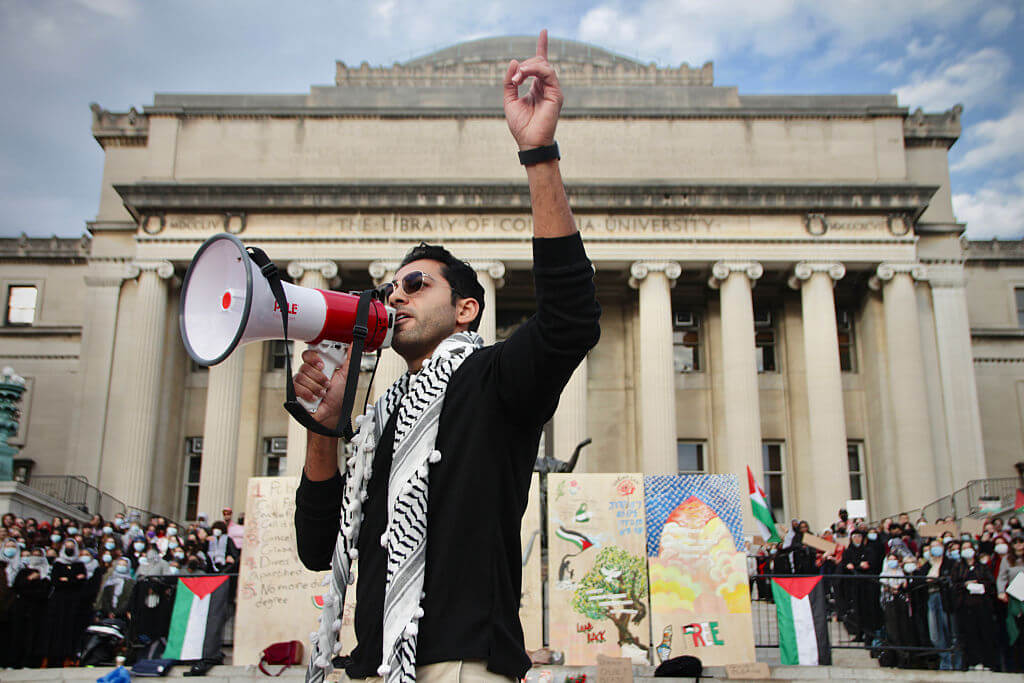Israel concedes to ‘disturbing’ demand by Poland: Students should visit memorials to murderers of Jews
Experts slam it as ‘a dream come true for Holocaust deniers’ that glorifies ‘Poles who were involved up to their necks in the murder of Jews’
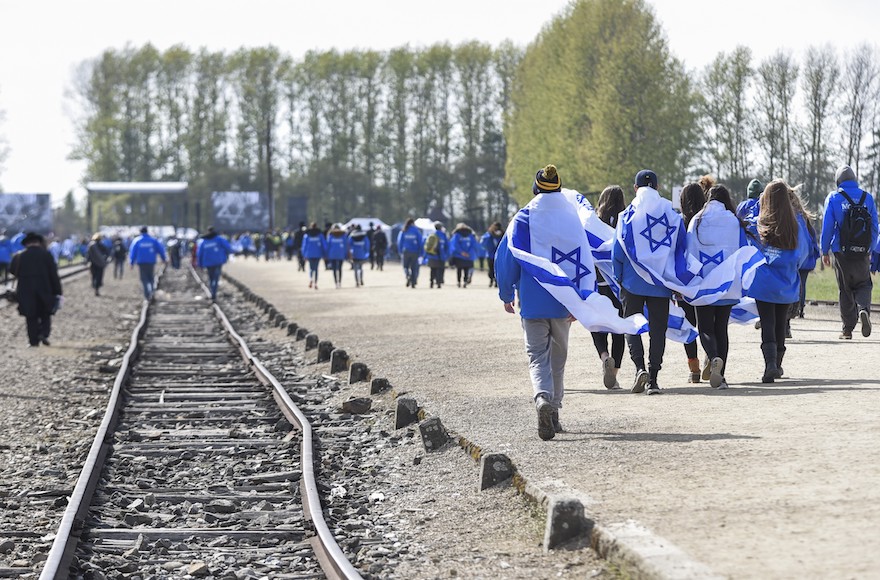
March of the Living participants carrying Israeli flags at the former Nazi Auschwitz-Birkenau concentration camp at Oswiecim in Krakow, Poland, April 24, 2017. Photo by Getty Images
This article originally appeared on Haaretz, and was reprinted here with permission. Sign up here to get Haaretz’s free Daily Brief newsletter delivered to your inbox.
The agreement that Israel and Poland signed last month, intended to allow Israeli youth delegations to Poland to resume, is “a surrender to Polish propaganda” and “a dream come true for Holocaust deniers,” top historians and scholars of Polish Jewry and the Holocaust told Haaretz.
Last year, Israel’s Education Ministry announced that it was cancelling organized Holocaust-education missions for Israeli teenagers to Poland because of the Polish government’s attempts to interfere with the content of the programs, according to then-Foreign Minister Yair Lapid. This was part of an ongoing crisis between the two countries regarding narratives of the Holocaust.
The agreement to renew such programs was signed by the Israeli and Polish foreign ministers, Eli Cohen and Zbigniew Rau. It now awaits ratification by the Knesset and the Polish parliament, but the signing alone paved the way for the immediate resumption of the youth trips. This is the first time that the details of the agreement are being revealed to the public.
At the core of the agreement is a section that stipulates that Israeli students, who usually tour extermination camps and other sites related to the Holocaust of the Jewish people, may visit sites related to “other crimes of World War II.” This refers to museums and memorial sites that document crimes committed by the Germans against non-Jewish Poles. The agreement also includes an appendix with a list of such sites, from which the Israeli student delegations must select at least one to visit.
Professor Havi Dreifuss, a historian at Tel Aviv University and Yad Vashem, called this list of sites “outrageous” and says that “most of them are dubious at best and controversial at worst.” She notes that some of the sites on the list “ignore documented aspects of Poles’ involvement in the murder of Jews,” and others actually “glorify Poles who were involved up to their necks in the murder of Jews.”
Professor Jan Grabowski, a Polish-Canadian historian whose research focuses on the Holocaust of Polish Jewry, was even more scathing in his description of this list: “What you have there is the ‘Polish wish-list’ of where Israeli youth should go. It reads like a Holocaust denier’s dream,” he says.
Dreifuss and Grabowski direct most of their criticism at the list’s inclusion of the Markowa Ulma-Family Museum of Poles Who Saved Jews in World War II, which opened in 2016. The museum, located in the village of Markowa, highlights the story of the Polish Ulma family, who hid eight Jews in their home and paid for it with their lives.
The historians mainly take issue with the fact that the museum aims to portray Poles as a nation of rescuers of Jews while ignoring more recent research, which shows that such heroes were a drop in the bucket compared to the vastly more common phenomenon of Poles aiding the Germans, either by turning in Jews or by helping to kill them. This museum “should be avoided at all costs,” Grabowski warns. “If there were a museum of Holocaust distortion, this would be it.”
Two more of the list’s sites that the scholars find controversial are museums dedicated to the “forsaken soldiers,” the term for post-World War II fighters in the Polish underground who battled the country’s communist occupation. They are revered as national heroes in Poland, even though, as Grabowski notes, some of them were “ruthless murderers of Jews during and after the war.” One prominent figure among them was Jozef Kuras, also known as “Ogien,” meaning “fire.” Scholars maintain that he was involved in the murder of Jewish men, women and children in Poland.
“Israel’s readiness to go along with this double discussion of the Holocaust and World War II is very disappointing,” Dreifuss says, referring to the parallel being drawn between Jewish suffering in the Holocaust and Polish suffering during the war.
Professor Daniel Blatman of the Hebrew University, who also serves as chief historian of the Warsaw Ghetto Museum (which, though currently under construction, is also featured on the Polish government’s list of recommended), takes a different, more nuanced approach. He says that, as a whole, the agreement constitutes “Israeli recognition of the Polish narrative that views the Polish nation as a victim of the German and Soviet occupation.”
Accordingly, he says, “the inclusion of a substantial number of museums and sites that deal with the history of Poland, and especially with Polish martyrology and heroism during the era of German rule, is a significant move [on Israel’s part] toward the Polish position, which insists on recognition of Poland’s history in the ‘dark years’ of the German occupation and communist rule.” He says that this is a positive development, and is important not only for Poland, but also for Israeli youth “to learn about and get to know the history of the country they are visiting.”
At the same time, he is critical of the agreement for not containing a “single word” about “the issue of Poles’ collaboration in the surrendering and murder of Jews during the German occupation.”
Scholars are also displeased that the agreement does not correspond to the original declared aims of the trips to Poland. Meir Bulka, a research fellow at Bar-Ilan University’s Finkler Institute of Holocaust Research and chairman of J-nerations, an organization that seeks to preserve Jewish heritage in Europe, is highly critical of the agreement on this point. “If you are the parent of an Israeli high school student, take note – from now on, your money is also funding this Polish propaganda, and this is only happening because of the failure of Israeli politicians and diplomats, who signed the agreement with no understanding of what it means,” he charges.
Bulka points out that, according to the Education Ministry, these trips to Poland are meant “to strengthen Israeli youth’s bond with the Jewish people’s past and to engage with Israeli identity.” However, he says, rather than being a trip for learning about the Holocaust, the trip is now liable to become “a trip for learning about Polish suffering and for promoting the Polish people, while thumbing its nose at history and the Jewish narrative.”
The agreement is accompanied by an explanation, which says that the pact is intended to bring Israelis and Poles closer, in part through “educational visits to sites that commemorate the Holocaust and other crimes of World War II, and other sites of special importance to the history of each nation.”
It continues: “The two countries have a shared historic heritage that provides a basis for the easing of bilateral relations.” According to the agreement, visits by young Israelis to Poland and by young Poles to Israel represent “an important stage in building continued relations between Israel and Poland and their peoples.”
It also says that the agreement aims to prevent Israeli and Polish youth from developing “negative ethical and moral views toward one another, such as racism and xenophobia” that stem, the agreement says, “from a lack of knowledge and insufficient education among the younger generations.” The terms “antisemitism” and “anti-Polonism” – used by Poles to refer to hatred of their people – were both omitted from this section.
Many scholars find the fact that Israeli and Polish youth are being jointly called upon to combat hatred of the other to be controversial in and of itself. They say it is inappropriate to compare hatred of Jews – antisemitism – which is a widespread, global, centuries-old phenomenon that was one of the causes of the Holocaust, with anti-Polonism, which derives, among other things, from the role played by Poles in exacerbating antisemitism and in participating in the Holocaust.
The Forward is free to read, but it isn’t free to produce

I hope you appreciated this article. Before you go, I’d like to ask you to please support the Forward.
Now more than ever, American Jews need independent news they can trust, with reporting driven by truth, not ideology. We serve you, not any ideological agenda.
At a time when other newsrooms are closing or cutting back, the Forward has removed its paywall and invested additional resources to report on the ground from Israel and around the U.S. on the impact of the war, rising antisemitism and polarized discourse.
This is a great time to support independent Jewish journalism you rely on. Make a gift today!
— Rachel Fishman Feddersen, Publisher and CEO
Support our mission to tell the Jewish story fully and fairly.
Most Popular
- 1

Culture Cardinals are Catholic, not Jewish — so why do they all wear yarmulkes?
- 2

Fast Forward Ye debuts ‘Heil Hitler’ music video that includes a sample of a Hitler speech
- 3

News School Israel trip turns ‘terrifying’ for LA students attacked by Israeli teens
- 4

Fast Forward Student suspended for ‘F— the Jews’ video defends himself on antisemitic podcast
In Case You Missed It
-
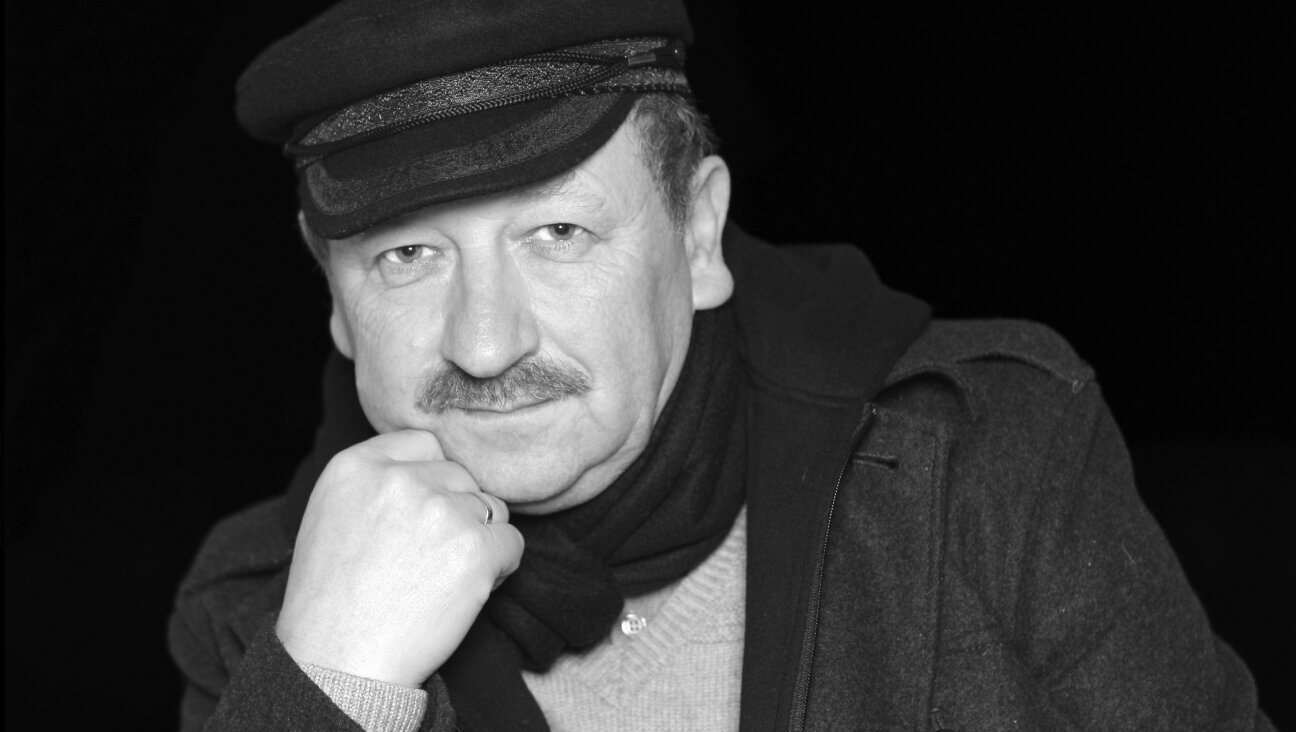
Yiddish קאָנצערט לכּבֿוד דעם ייִדישן שרײַבער און רעדאַקטאָר באָריס סאַנדלערConcert honoring Yiddish writer and editor Boris Sandler
דער בעל־שׂימחה האָט יאָרן לאַנג געדינט ווי דער רעדאַקטאָר פֿונעם ייִדישן פֿאָרווערטס.
-

Fast Forward Trump’s new pick for surgeon general blames the Nazis for pesticides on our food
-
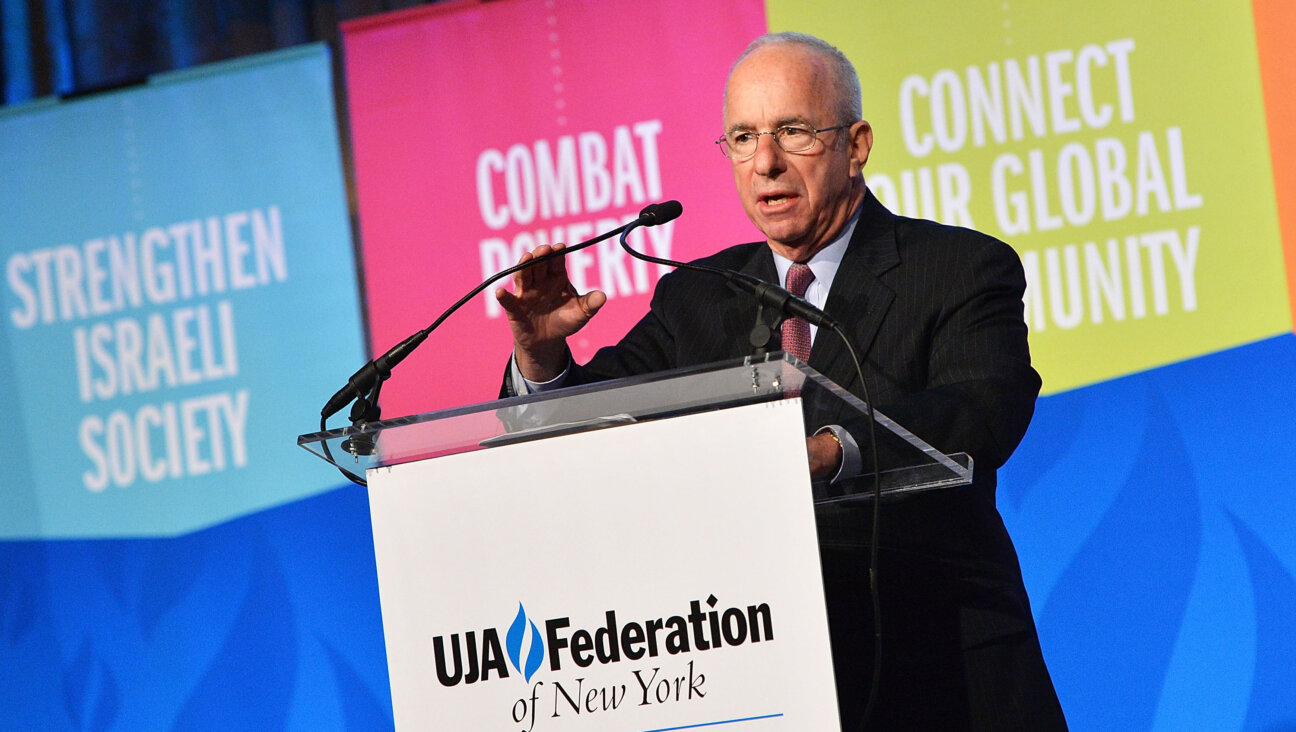
Fast Forward Jewish feud over Trump escalates with open letter in The New York Times
-
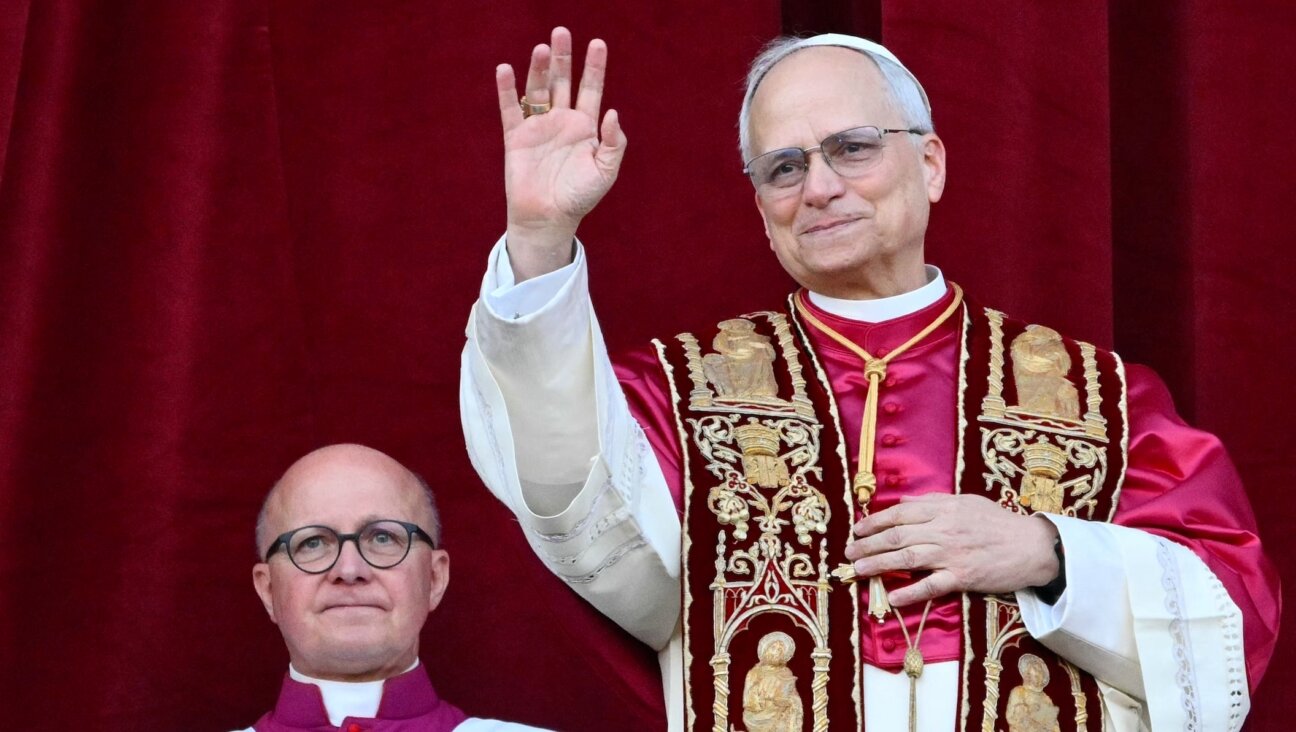
Fast Forward First American pope, Leo XIV, studied under a leader in Jewish-Catholic relations
-
Shop the Forward Store
100% of profits support our journalism
Republish This Story
Please read before republishing
We’re happy to make this story available to republish for free, unless it originated with JTA, Haaretz or another publication (as indicated on the article) and as long as you follow our guidelines.
You must comply with the following:
- Credit the Forward
- Retain our pixel
- Preserve our canonical link in Google search
- Add a noindex tag in Google search
See our full guidelines for more information, and this guide for detail about canonical URLs.
To republish, copy the HTML by clicking on the yellow button to the right; it includes our tracking pixel, all paragraph styles and hyperlinks, the author byline and credit to the Forward. It does not include images; to avoid copyright violations, you must add them manually, following our guidelines. Please email us at [email protected], subject line “republish,” with any questions or to let us know what stories you’re picking up.








